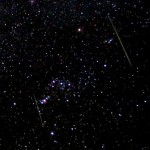The annual Geminid meteor shower has become one of the most reliable annual meteor showers. Known for bright and slow moving fireballs the Geminids can provide a good reason to spend a few hours outside on a December night. This shower has routinely provided rates above 100 meteors per hours in past years, this year should be no exception.

The peak is expected to occur around December 14, 06:30UT. For viewers here in Hawaiʻi this occurs on the evening of December 13th. The Geminids feature a broad peak, with high rates for nearly 24 hours, thus allowing the all time zones a decent chance to enjoy the show.
There should be no substantial moonlight to drown out this years showing, dark skies to allow even the faintest meteors to be seen. The Moon is a thin waxing crescent, 1% illuminated on the morning of the 13th, essentially new.
The Geminid radiant rises round 8pm, thus meteors should be visible all night long. You can stay up late or set the alarm early, your preference. Southern viewers will have to wait until around midnight for the constellation Gemini to rise, making this a morning shower.
Watching meteors requires no more equipment than your eyes and a dark sky, and can be enjoyable for just about anyone. Well? It is December, you should probably add a warm coat to the equipment list.
